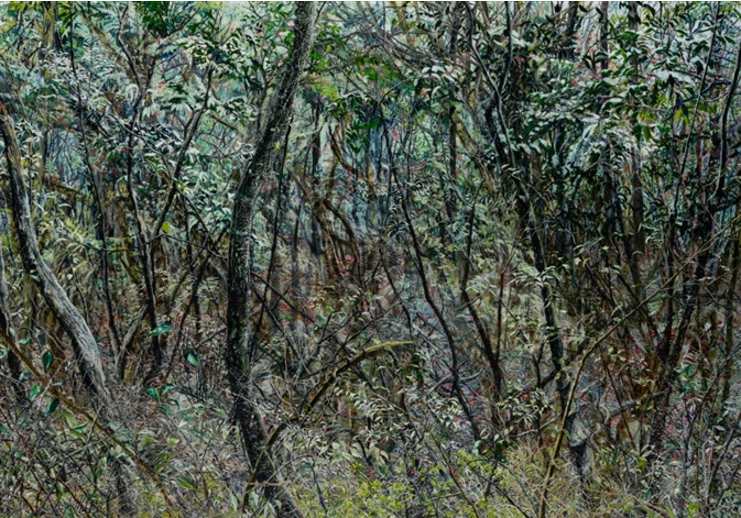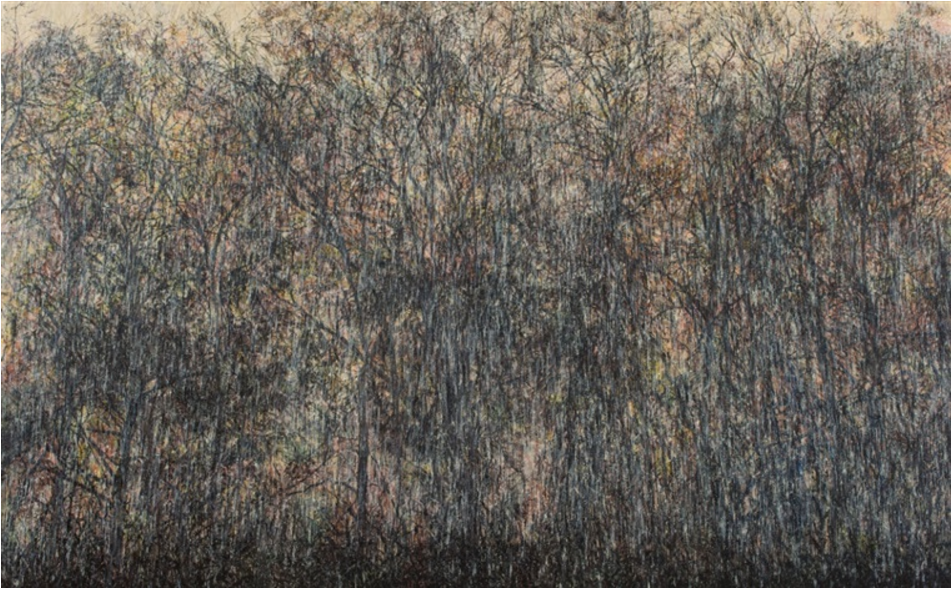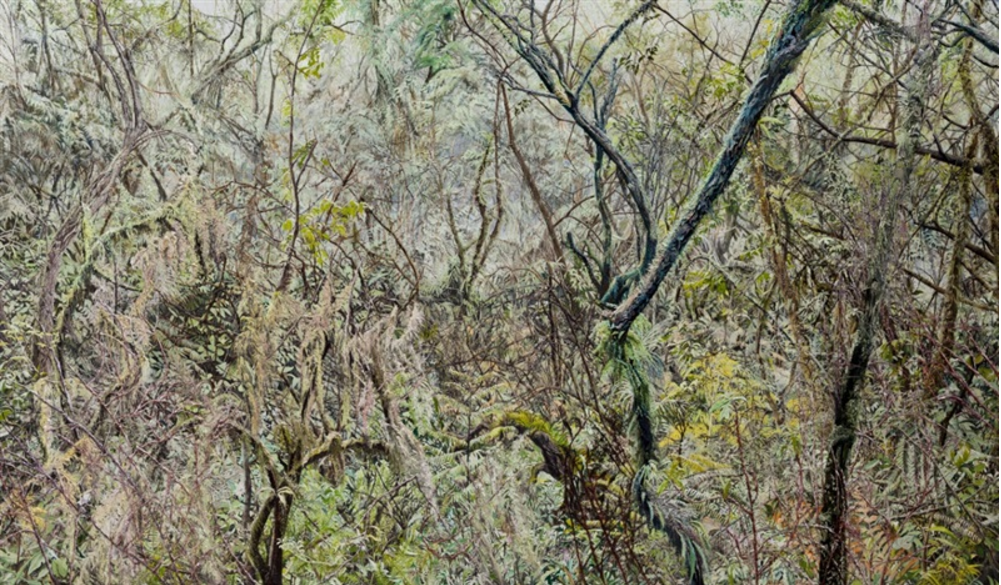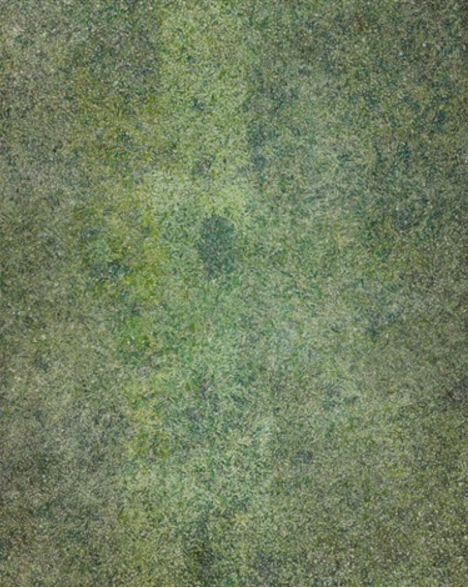People
artnet Asks: Artist Heo Suyoung and the Magic of Capturing Time in Paint
His current solo show just got extended through January 25.

His current solo show just got extended through January 25.

Artnet Galleries Team

Korean painter Heo Suyoung’s canvases are slow, all-encompassing scenes that take a long time to enter as a viewer. With lush, richly layered foliage and dense brush, his images teem with the visual complexity of the forest and manage to collapse and scale the passage of time. The young artist carefully labors over these works for at least a year, aiming to capture the turning of the seasons in one single image.
His current solo show at Hakgojae Gallery in Seoul has just been extended through January 25. Here, Heo Suyong explains his process and what it means to surrender and let the work itself guide you.
Many of your recent canvases seem to capture all four seasons in a single image. Can you explain that process?
I do not have a personal studio, so I apply to artist residencies and move around a lot. Artist residencies in Korea are usually one year long. I tried to think of a way I can make something of that year in a certain residency, so I started a painting series. I painted the views outside the windows of my studio assigned to me, and places I visit frequently during my stay.
The painting process starts from the season when I start my residency. For example, if it starts in spring, I start painting the bare branches of early spring. In the summer I paint thick, green leaves over the springtime scenery. In the fall, I over-paint red and yellow on top of green, and in the winter, I paint snow. Once the four seasons are accumulated, the paintings are finished and my residency ends as well. Although I try to paint daily—as detailed as possible—the objects overlap, paint accumulates, the surface of the painting thickens and the image becomes abstract and expressive, as memory transforms into reminisce. I aspire to collect still moments and create a flowing pattern of time.

Heo Suyong, Yangsandong 09 (2013). Courtesy of Hakgojae Gallery.
Can you tell us about your current solo exhibition at Hakgojae Gallery?
The exhibition at Hakgojae Gallery contains 16 works that I have worked on for the past three years. I have set a time limit of a year in which I can work on the painting, yet I occasionally find a spot I want to fix or add more after the year term, and sometimes I go against the rule I set for myself and paint more. This causes the balance of brushstrokes to collapse and I have to repaint the whole painting again, according to the added brushstrokes.
When I paint, the traces of the brushstrokes become subjects such as grass or trees, and these subjects unite and create a space and become a kind of reproduction. Then when something is painted on top, the expression becomes a vestige once again. As I paint repeatedly like this, the painting becomes something new as it constantly changes its state. As the painting arrives at a certain point, I want to take that painting further into a place of ambiguity because I want my painting to be at a point where language cannot exist anymore, and be a painting as pure as it can possibly be.
As I paint more on a painting, other paintings seem like they need to be filled up more, and I paint endlessly again and again. I believe endless brushstrokes create a true painting, and the paintings I have painted over the past three years with that belief are in the exhibition at Hakgojae Gallery.

Heo Suyong, Forest 2 (2015). Courtesy of Hakgojae Gallery.
How do you know when a painting is done?
I consider my paintings complete when it is no longer penetrable. However, when I re-observe paintings that I could no longer work on due to tiredness and have put away, I find places that I think I could add more brushstrokes. So I paint again on that painting, and that leads me to paint another layer all over the painting, and I think the painting matures through this process. However, the painting is not certainly “finished,” as I may find another spot where I can add on more brushstrokes. There is no end in painting. The time I observe the “finished” work is the time I search for a spot where I can maybe penetrate more as well. I do not separate my final result and the process, as it is impossible to say that the process of my works is “finished.”
What were the biggest challenges in creating this body of work?
Like anyone else, I always hope that each painting is better than the one I painted before. But not all hopes are realized. I doubt myself as an artist when I feel that I haven’t overcome my previous painting. I have painted the forest a lot, because the grass and trees that make up the forest are subjects that become grids in the space and they help me create depth within the painting. I am not yet familiar with successfully painting under the ocean or the depth of the sky.
I think my biggest challenge and when I am frustrated the most is when I find my limits when painting, but cannot find the solution for it.

Heo Suyong, Grass 2 (2016). Courtesy of Hakgojae Gallery.
Do you ever experience artist’s block? What do you do to overcome it?
When I get tired or need refreshing, I take walks, drink, or just sleep. When that doesn’t work, I just keep on painting. When I force myself to paint, my brushstrokes are temperamentally rough and insincere.
When I look at this, I remind myself I need to paint again with delicacy and sincerity. I think it is important to express my honest emotions in my paintings because it reflects my life as a painter, so rather than trying to overcome a block, I expose myself in my paintings.
The artnet Gallery Network is a community of the world’s leading galleries offering artworks by today’s most collected artists. Learn more about becoming a member here, or explore our member galleries here.